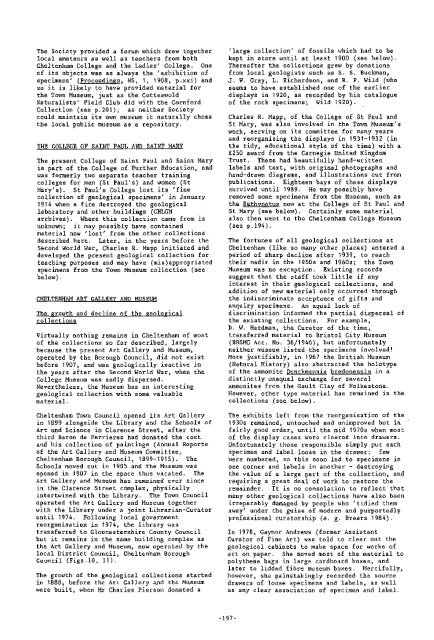Number 5 - Geological Curators Group
Number 5 - Geological Curators Group
Number 5 - Geological Curators Group
Create successful ePaper yourself
Turn your PDF publications into a flip-book with our unique Google optimized e-Paper software.
The Society provided a forum which drew togetherlocal amateurs as well as teachers from bothCheltenham College and the Ladies' College. Oneof its objects was as always the 'exhibition ofspecimens' (Proceedines, NS, 1, 1908, p.xxi) andso it is likely to have provided material farthe Town Museum, just as the CatteswoldNaturalists' Field Club did with the CornfordCollection (see p.201); as neither Societycould maintain its own museum it naturally chosethe local public museum as a repository.THE COLLEGE OF SAINT PAUL AND SAINT MARYThe present College of Saint Paul and Saint Maryis part of the College of Further Education, andwas formerly two separate teacher trainingcolleges for men (St Paul's) and women (StMary's). St Paul's College lost its 'finecollection of geological specimens' in January1914 when a fire destroyed the geologicallaboratory and other buildings (CHLGMarchives). Where this collection came from isunknown; it may possibly have containedmaterial now 'lost' from the other collectionsdescribed here. Later. in the vears before theSecond World War, charies R. ~ a initiated p ~ anddeveloped the present geological collection forteaching purposes and may have (mis)appropriatedspecimens from the Town Museum collection (seebelow)CHELTENHAM ART GALLERY AND MUSEUMThe erowth and decline of the eealoaicalcollectionsVirtually nothing remains in Cheltenham of mostof the collections so far described, largelybecause the present Art Gallery and Museum,operated by the Borough Council, did not existbefore 1907, and was geologically inactive inthe years after the Second World War, when theCollege Museum was sadly dispersed.Nevertheless, the Museum has an interestinggeological collection with some valuablematerial.Cheltenham Town Council opened its Art Galleryin 1899 alongside the Library and the Schools ofArt and Science in Clarenee Street, after thethird Baron de Ferrieres had donated the costand his collection of paintings (Annual Reportsof the Art Gallery and Museum Committee,Cheltenham Borough Council, 1899-1915). TheSchools moved out in 1905 and the Museum wasopened in 1907 in the space thus vacated. TheArt Gallery and Museum has remained ever sincein the Clarence Street complex, physicallyintertwined with the Library. The Town Counciloperated the Art Gallery and Museum togetherwith the Library under a joint Librarian-Curatoruntil 1974. Following local governmentreorganisation in 1974, the library wastransferred to Gloucestershire County Councilbut it remains in the same building complex asthe Art Gallery and Museum, now operated by thelocal District Council, Cheltenham BoroughCouncil (Figs.10, 11).The growth of the geological collections startedin 1888, before the Art Gallery and the Museumwere built, when Mr Charles Pierson donated a'large collection' of fossils which had to bekept in store until at least 1900 (see below).Thereafter the collections grew by donationsfrom local geologists such as S. S. Buckman,J. W. Gray, L. Richardson, and R. P. Wild (whoseems to have established one of the earlierdisplays in 1920, as recorded by his catalogueof the rock specimens; Wild 1920).Charles R. Mapp, of the College of St Paul andSt Mary, was also involved in the Town Museum'swork, serving on its committee for many yearsand reorganising the displays in 1931-1932 (inthe tidy. educational stvle of the time) with af250 awkid from the ~ar&ie United ~ingdomTrust. These had beautifully hand-writtenlabels and text, with original photographs andhand-drawn diagrams, and illustrations cut frompublications. Eighteen bays of these displayssurvived until 1989. He may possibly haveremoved some specimens from the Museum, such asthe Euthvnotus now at the College of St Paul andSt Mary (see below). Certainly some materialalso then went to the Cheltenham College Museum(see p.194).The fortunes of all geological collections atCheltenham (like so many other places) entered aperiod of sharp decline after 1939, to reachtheir nadir in the 1950s and 1960s; the TownMuseum was no exception. Existing recordssuggest that the staff took little if anyinterest in their geological collections, andaddition of new material only occurred throughthe indiscriminate acceptance of gifts andenquiry specimens. An equal lack ofdiscrimination informed the partial dispersal ofthe existing collections. For example,D. W. Herdman, the Curator of the time,transferred material to Bristol City Museum(BRSMG Acc. No. 36/1946), but unfortunatelyneither museum listed the specimens involved!More justifiably, in 1967 the British Museum(Natural History) also abstracted the halotypeof the ammonite Denckmannia bredonensis in adistinctly unequal exchange for severalammonites from the Gault Clay of Folkestone.However, other type material has remained in thecollections (see below).The exhibits left from the reorganisation of the1930s remained, untouched and unimproved but infairly good order, until the mid 1970s when mostof the display cases were cleared into drawers.Unfortunately those responsible simply put eachspecimen and label loose in the drawer; fewwere numbered, so this soon led to specimens inone corner and labels in another - destroyingthe value of a large part of the collection, andrequiring a great deal of work to restore theremainder. It is no consolation to reflect thatmany other geological collections have also beenirreparably damaged by people who 'tidied themaway' under the guise of modern and purportedlyprofessional curatorship (e. g. Brears 1984).In 1978, Gaynor Andrews (former AssistantCurator of Fine Art) was told to clear out thegeological cabinets to make space for works ofart on paper. She moved most of the material topolythene bags in large cardboard boxes, andlater to lidded fibre museum boxes. Mercifully,however, she painstakingly recorded the sourcedrawers of loose specimens and labels, as wellas any clear association of specimen and label.
















